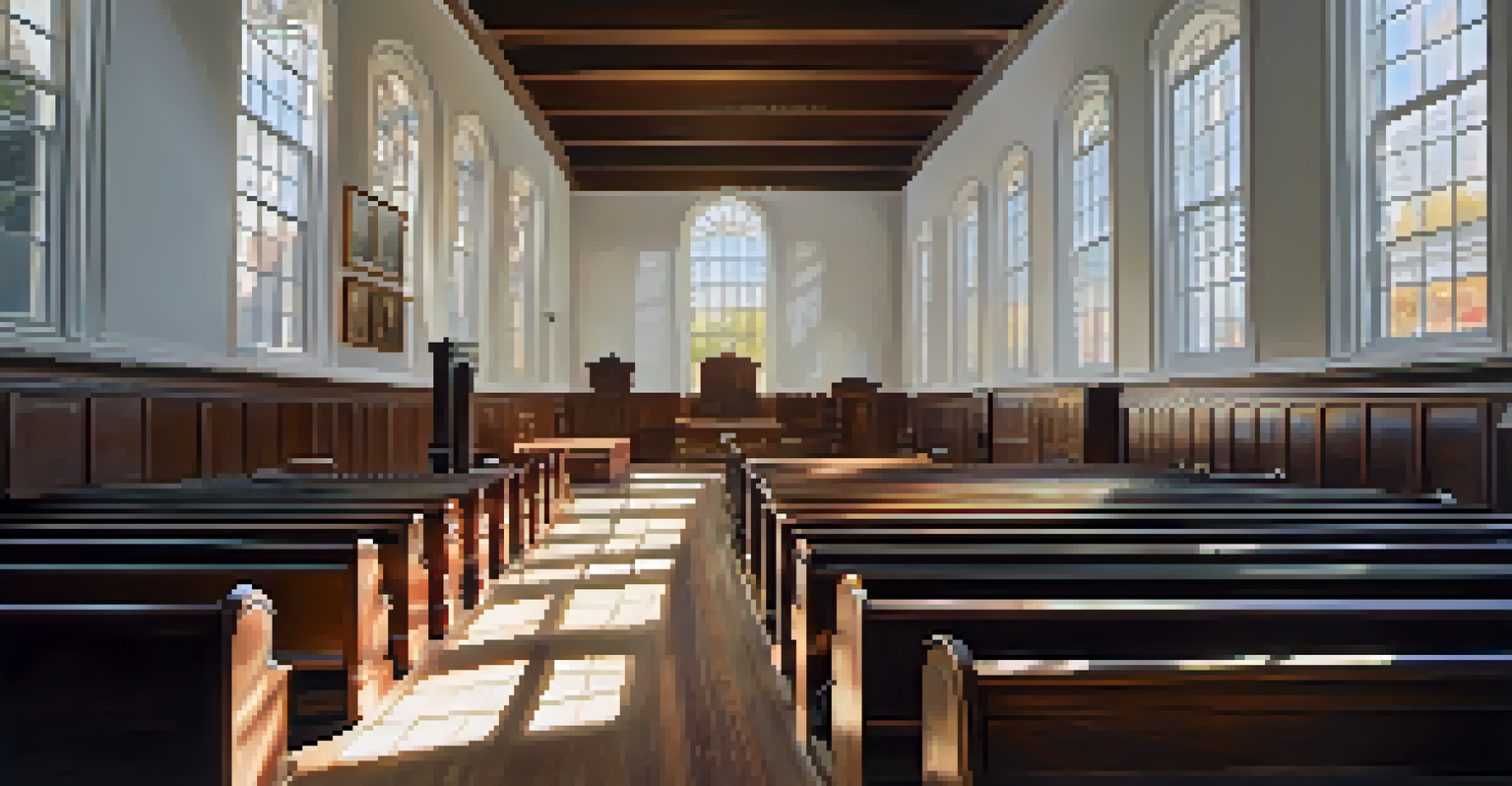Walking the Freedom Trail: Boston's Historic Revolution Sites

Introduction to the Freedom Trail: A Historic Pathway
The Freedom Trail is a 2.5-mile-long path that weaves through Boston, connecting 16 significant historical sites. This trail serves as a vivid reminder of the American Revolution and the pivotal moments that shaped our nation. Starting at Boston Common, the trail invites visitors on a journey through time, enriching their understanding of American history.
Freedom is never given; it is won.
As you walk along the red-brick line that marks the trail, you'll encounter a mix of museums, churches, and burial grounds, each telling its own unique story. This pathway not only showcases Boston's rich history but also offers a chance to enjoy the city's vibrant culture and stunning architecture. Whether you're a history buff or just looking for a pleasant stroll, the Freedom Trail has something for everyone.
So, lace up your walking shoes and prepare to step back in time as we delve into the highlights of this historic trail, uncovering the stories behind the sites that played crucial roles in America's fight for independence.
Boston Common: The Starting Point of Your Journey
Boston Common, established in 1634, is the oldest public park in the United States and serves as the starting point for the Freedom Trail. This expansive green space has been a gathering place for locals and visitors alike, hosting protests, performances, and leisurely picnics. Its historical significance is palpable, as it was once used for public hangings and military training.

As you begin your walk, take a moment to soak in the beauty of the park, with its lush lawns, tranquil ponds, and charming pathways. The Common is not just a scenic spot; it also offers a glimpse into the early days of Boston's history and the struggles faced by its residents. It's the perfect place to reflect on the journey ahead.
Explore Boston's Rich History
The Freedom Trail is a 2.5-mile path connecting 16 historical sites that highlight significant events from the American Revolution.
From Boston Common, you’ll find the trail marked clearly, guiding you towards your next historical stop. With each step, you're not just walking; you’re tracing the footsteps of those who fought for freedom and justice.
The Massachusetts State House: A Symbol of Democracy
Just a short walk from Boston Common, you'll encounter the stunning Massachusetts State House, with its iconic golden dome gleaming in the sunlight. Built in 1798, this building is a symbol of democracy and an architectural marvel, designed by Charles Bulfinch. It houses the offices of the Governor and the Massachusetts General Court, making it a vital hub of state government.
The price of freedom is eternal vigilance.
Visitors can explore the State House through guided tours, where you’ll learn about its rich history and the legislative process in Massachusetts. The building is adorned with beautiful artwork and historical artifacts, each telling a story of the state's past. The dome itself is an impressive sight, representing the ideals of freedom and governance.
As you stand before this historic building, take a moment to appreciate its significance in shaping the political landscape of America. It’s a powerful reminder of the values our founding fathers fought for and the ongoing journey toward a more perfect union.
Park Street Church: A Beacon of Hope and Change
Next on the trail is Park Street Church, an influential landmark that has played a key role in Boston's history since its establishment in 1809. With its striking steeple reaching high into the sky, it was once the tallest building in the city. This church has been a significant site for abolitionist meetings and social reform, advocating for change and justice in the community.
As you enter, you’ll find beautiful stained-glass windows and a welcoming atmosphere that invites reflection. Park Street Church has a rich musical heritage as well, hosting renowned choirs and performances that resonate through its hallowed halls. It's a place where faith and social action intersect, reminding us of the power of community.
Key Stops Along the Trail
Visitors can discover iconic landmarks such as Boston Common, the Massachusetts State House, and Faneuil Hall, each with its own unique story.
Standing in front of Park Street Church, you can feel the weight of history and the enduring spirit of those who gathered here to fight for what they believed in. It’s a poignant stop on your journey along the Freedom Trail, highlighting the role of faith in the quest for freedom.
Granary Burying Ground: Resting Place of Revolutionaries
A short stroll will lead you to the Granary Burying Ground, one of the oldest cemeteries in Boston, dating back to 1660. This somber yet fascinating site is the final resting place of several notable figures from the American Revolution, including Samuel Adams, John Hancock, and Paul Revere. Walking among the weathered gravestones, you can almost hear the whispers of history echoing through the ages.
The cemetery is rich with stories, as each gravestone tells a tale of the lives and contributions of those buried here. The intricate carvings and inscriptions offer a glimpse into the past, reminding us of the sacrifices made for our freedom. It's a moment to pause and reflect on the legacy of these revolutionary leaders.
Visiting Granary Burying Ground is not just about honoring the dead; it’s about connecting with the ideals they fought for. This site emphasizes the human cost of the revolution, making it a poignant reminder of our nation's struggle for independence.
The Old South Meeting House: A Hub of Revolutionary Ideas
As you continue along the Freedom Trail, you’ll find the Old South Meeting House, where the seeds of revolution were sown. Built in 1729, this historic church became a gathering place for Bostonians to discuss and debate the issues of the day. It was here that fiery speeches were made, and plans for resistance against British rule were hatched, leading to events like the Boston Tea Party.
Today, the Old South Meeting House functions as a museum, offering insights into the turbulent times leading up to the American Revolution. Visitors can explore exhibits that showcase the debates and discussions held within these walls, providing a deeper understanding of the political climate of the era. The building itself is a stunning example of early American architecture.
Reflect on Freedom's Legacy
Walking the Freedom Trail offers an immersive experience that encourages reflection on the values of justice and equality that continue to shape America today.
Standing in this historic space, you can almost feel the passion and fervor that filled the air during those crucial meetings. It’s a powerful reminder of the importance of free speech and civic engagement, principles that are still vital in our society today.
Faneuil Hall: The Cradle of Liberty
Faneuil Hall, often referred to as the 'Cradle of Liberty,' is a vibrant marketplace and a historic site that has witnessed countless debates and discussions about freedom. Built in 1742, it served as a meeting place for American colonists to voice their opposition to British policies. Today, it stands as a bustling hub filled with shops, eateries, and street performers, blending history with modern-day life.
Inside Faneuil Hall, you can explore exhibits that highlight its role in American history, including the famous speeches delivered by figures such as Samuel Adams. The hall has hosted many significant events, making it a cornerstone of Boston's revolutionary spirit. As you wander through its halls, you can almost hear the echoes of impassioned voices calling for change.

Visiting Faneuil Hall is not just about appreciating its historical significance; it’s about experiencing the lively atmosphere that continues to thrive today. It’s a perfect stop to grab a bite to eat while immersing yourself in the heart of Boston's historical narrative.
Conclusion: Reflecting on Your Journey Along the Freedom Trail
Walking the Freedom Trail is more than just a sightseeing tour; it's an immersive experience that connects you with the rich tapestry of American history. Each site along the trail offers unique insights into the struggles and triumphs of those who fought for freedom, making the journey both educational and inspiring. It’s a path that invites reflection on the values we hold dear today.
As you complete your walk, take a moment to consider the impact of the events that transpired in Boston. The stories of courage and resilience resonate with us, reminding us of the ongoing fight for justice and equality in our own time. The Freedom Trail encourages us to honor the past while actively engaging in the present.
So, whether you're a local or a visitor, make sure to take the time to explore this historic trail. It’s not just a walk through Boston; it's a walk through the heart of American history, leaving you with a deeper appreciation for the freedoms we enjoy today.